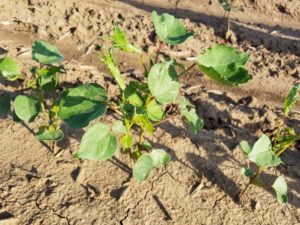by Gaylon Morgan, Pete Dotray, and Scott Nolte
Numerous complaints have been received from the off-target movement of auxin herbicides in parts of South and East Texas over the past two weeks. Due to the extremely high sensitivity of cotton to 2,4-D, it is not too surprising that most of the incidents appear to be off-target movement of 2,4-D. In much of Texas, observing 2,4-D injury in cotton is common, but some of the incidents this year do appear to be from applications in row crops. We do not have the specific application records for each of these incidents, and know that the off-target movement of the auxin herbicides is in large part the result of not following the application requirements specified on the product labels, including confusion that wind blowing in the direction of susceptible crops (non-Enlist cotton) cannot be overcome by the use of in-field buffers (which are only in place to protect against sensitive areas), incorrect spray nozzles, excessive boom heights, inappropriate tank mix partners, and spraying in a temperature inversion.
Due to the incidences that have already occurred in South and East Texas, Texas Department of Agriculture is well-aware of the situation and will be taking action to minimize off-target movement into the future. Specifically, TDA will increase the number of use observations and applicator record inspections in areas with higher probability of off-target complaints and also will increase their interactions with distributors. If these auxin herbicides cannot be kept on-target, the potential for additional federal and/or state restrictions can be implement, OR, access to these products could be lost all together.
Texas A&M AgriLife Extension Service made a major effort to education applicators about the application requirements for XtendiMax, Engenia, and FeXapan, per the required mandatory Auxin training. As of May 15, 2018, it is estimated that over 6400 licensed and unlicensed applicators were trained by Extension and another 580 were trained by Monsanto and BASF at over 180 certification trainings that occurred in English and Spanish. Although the vast majority of the principles discussed in the Auxin Trainings were relevant to Enlist, no mandatory training was required. So, the focus of this article is on the application requirements for Enlist herbicides in cotton. See below.
Enlist One and Enlist Duo application requirements:
- IF THE WIND IS BLOWING TOWARDS ADJACENT SUSCEPTIBLE CROPS, DO NOT APPLY Enlist Duo or Enlist One. These susceptible crops include Cotton without the Enlist trait, Grapes, commercially grown tomatoes and other fruiting vegetables (EPA CROP GROUP 8 and 9). NO BUFFER DISTANCE will suffice when the wind is blowing towards these crops.
- A minimum 30 foot buffer is required between the application area and a sensitive area (THIS SENSITIVE AREA IS NOT THE SAME AS THE SUSCEPTIBLE PLANTS LISTED ABOVE).
- DO NOT apply under circumstances where spray drift may occur to food, forage, or other plantings that might be damaged or crops thereof rendered unfit for sale, use or consumption. DO NOT allow contact of herbicide with foliage, green stems, exposed non-woody roots.
- DO NOT apply at wind speeds greater than 10 MPH in Texas. Although not included on the label, applications should not be made with wind speeds less than 3 mph, because winds speeds above 3 mph helps ensure that a temperature inversion is not occurring.
- Use only approved nozzles and operating pressures listed on the product labels. Several nozzle models for each of these manufacturers are currently approved for Enlist One and Enlist Duo applications. Consult the label for the maximum operating pressures for each nozzle to minimize driftable fine spray droplets.
- ABJ Agri, GreenLeaf, Hypro, Lechier, TeeJet, and Wilger
- Enlist Duo and Enlist One may only be tank-mixed with products that have been tested and found not to adversely affect the spray drift properties. A list of those products may be found at EnlistTankmix.com . Visit this site no more than 7 days before applying these products.
- Use the minimum boom height based upon the nozzle manufacturer’s directions. For all the nozzles listed on the label, the boom height should not exceed 20”.
- Under low relative humidity conditions, larger droplets will reduce droplet evaporation. Droplet evaporation is most severe when conditions are both hot and dry.
- DO NOT make applications during local, low level temperature inversions because of increased drift potential. These conditions typically begin to occur as the sun sets and often continue into the morning hours. These conditions are common on nights with limited cloud cover and light to no winds.
- Thoroughly clean equipment used to apply these products before using the equipment to apply other chemicals. Consult the product labels for sprayer clean-out procedures.
- DO NOT aerially apply these products.
- DO NOT apply these products through any type of irrigation systems.

Dr. Gaylon Morgan
State Extension Cotton Specialist
College Station, TX
979-845-2425
gdmorgan@tamu.edu
